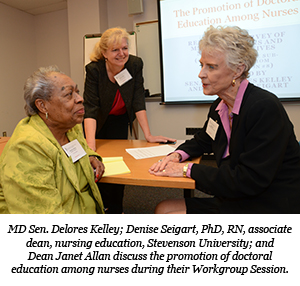News Archive, 1999 - 2020
State Summit Plans Response to Institute of Medicine Report on the Future of Nursing
September 29, 2011
 Baltimore, Md. – The Maryland Summit on the Future of Nursing drew leaders from nursing education and health care, and physicians, elected officials, state government organizations, and business leaders, to the University of Maryland School of Nursing (UMSON) on September 23 for a conference held in response to a 2010 ground-breaking Institute of Medicine (IOM) report, The Future of Nursing: Leading Change, Advancing Health.
Baltimore, Md. – The Maryland Summit on the Future of Nursing drew leaders from nursing education and health care, and physicians, elected officials, state government organizations, and business leaders, to the University of Maryland School of Nursing (UMSON) on September 23 for a conference held in response to a 2010 ground-breaking Institute of Medicine (IOM) report, The Future of Nursing: Leading Change, Advancing Health.
The purpose of the summit was to develop a strategic plan for implementing the recommendations of the IOM report in Maryland. The summit was led by the executive committee of the Maryland Action Coalition, one of 36 state-based coalitions named by the Future of Nursing: Campaign for Action. Maryland’s designation was announced Sept. 26 by the Center to Champion Nursing in America, an initiative of the Robert Wood Johnson Foundation (RWJF), the American Association of Retired Persons (AARP), and the AARP Foundation.
Janet D. Allan, PhD, RN, FAAN, dean of UMSON and founding member of the Maryland Action Coalition Executive Committee, welcomed the more than 200 participants to the all-day working conference. “This is a call to action for nursing, and for the country,” Allan said. “The vision of the IOM report is that all Americans have access to high-quality, patient-centered health care in a system where nurses contribute as essential partners in transforming the health care delivery system.”
Maryland Lt. Governor Anthony Brown urged the group to help the state meet an expected need for 11,000 new nurses by 2018. One way to strengthen the nursing workforce, he said, would be to increase the number of advanced degrees, thus making nurse educators “the force multiplier.”
“The Future of Nursing Campaign could not have come at a better time,” said, William D. Novelli, distinguished professor of the practice, Georgetown University McDonough School of Business and former CEO of AARP, in his keynote address. “The nation, indeed the entire world, is aging. Chronic disease management is becoming increasingly important. And so is advanced illness and end-of- life care.”
Novelli said he learned a lot more about the importance of America’s 3 million nurses when he served on the RWJF/IOM Committee on the Future of Nursing. “I came to see that nurses are the principal care providers to people of all ages in all health care settings….nurses can and must play a vital role in helping realize the objectives set forth in the 2010 Affordable Care Act.”
Deborah E. Trautman, PhD, RN, executive director, Johns Hopkins Medicine Center for Health Policy and Healthcare Transformation, presented “Linking the IOM Report and Health Care in Maryland.” She said health reform is needed because our nation’s current system is “expensive, ineffective, and unjust.”
Dean Allan noted in her remarks that to achieve the report’s vision, the RWJ/IOM committee “in its wisdom stated that a political/stakeholder coalition must be built around the report to help in the implementation.” For example, participants in the summit included Maryland Senator Delores Kelley and Paula Hollinger, RN, associate director, health workforce, Maryland Department of Health and Mental Hygiene and former member of the Maryland Senate.
The conference was organized into eight work groups—one for each IOM recommendation— to draft a strategic plan for implementing The Future of Nursing’s recommendations in Maryland. The recommendations are: Remove Scope-of-Practice Barriers; Expand Opportunities for Nurses to Lead and Diffuse Collaborative Improvement Efforts; Implement Nurse Residency Programs; Increase the Proportion of Nurses with a Bachelor of Science in Nursing degree to 80 percent by 2020; Double the Number of Nurses with a Doctorate by 2020; Ensure that Nurses Engage in Lifelong Learning; Prepare and Enable Nurses to Lead Change to Advance Health; and Build an Infrastructure for Collection/Analysis of Inter-professional Health Care Workforce Data.
In addition to Dean Allan, members of the Maryland Coalition Executive Committee are Neil Meltzer, MD, president and CEO, Sinai Hospital and senior vice-president, LifeBridge Health; Lynn Reed, executive director, Governor’s Workforce Investment Board; Frank Calia, MD, vice dean of clinical affairs, University of Maryland School of Medicine; Larry Strassner, PhD, RN, NEA-BC, vice president of patient care and CEO, Franklin Square Hospital and president, Maryland Organization of Nurse Executives; Kelly Nevins Petz, CRNA, president, Maryland Association of Nurse Anesthetists; Nancy Adams, MBA, RN, president, Maryland Board of Nursing; and Pat Travis, PhD, CCRP, RN, president, Maryland Nurses Association.
# # #
The University of Maryland School of Nursing, founded in 1889, is one of the oldest and largest nursing schools, and is ranked eleventh nationally. Enrolling more than 1,700 students in its baccalaureate, master’s, and doctoral programs, the School develops leaders who shape the profession of nursing and impact the health care environment